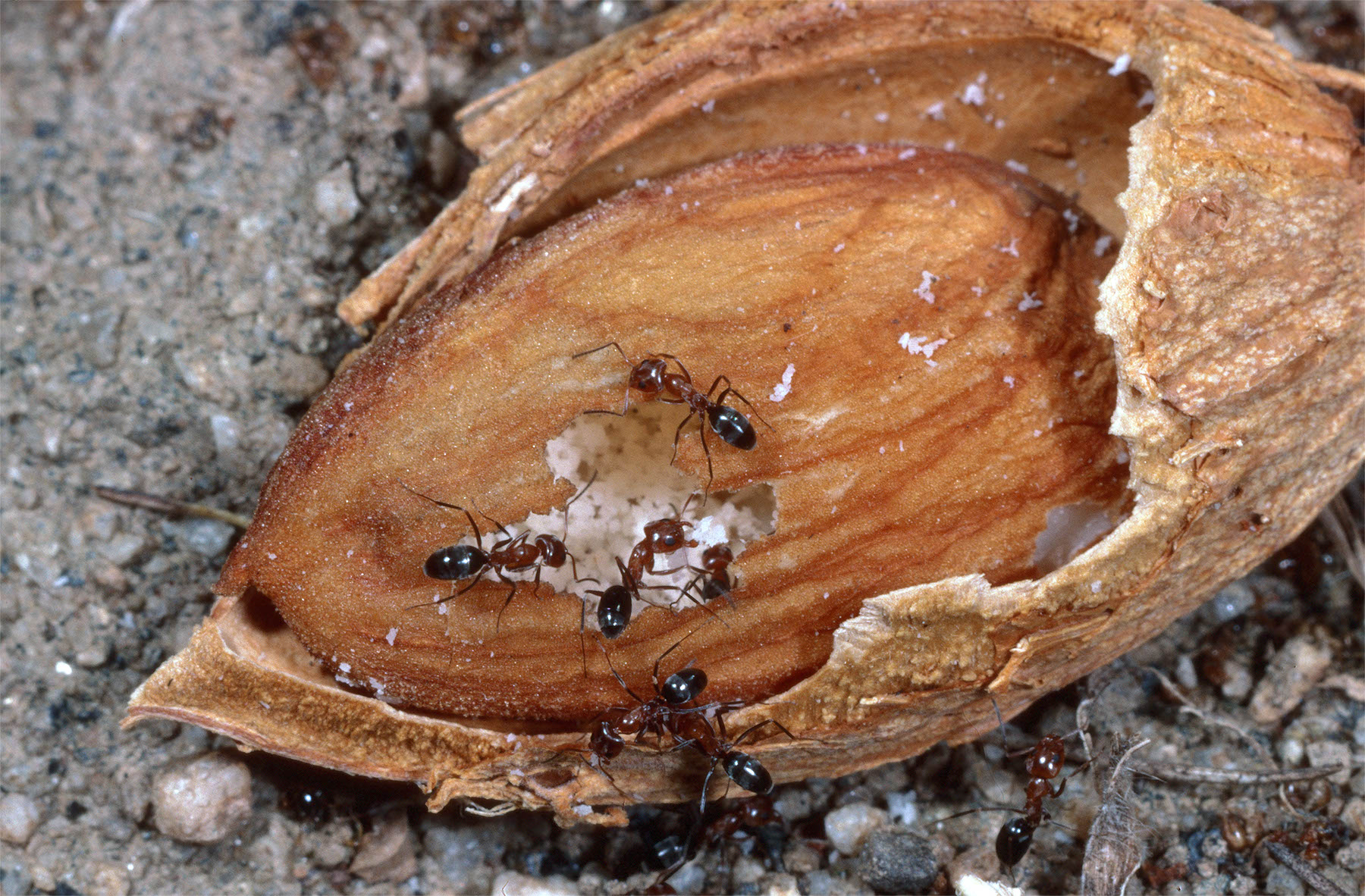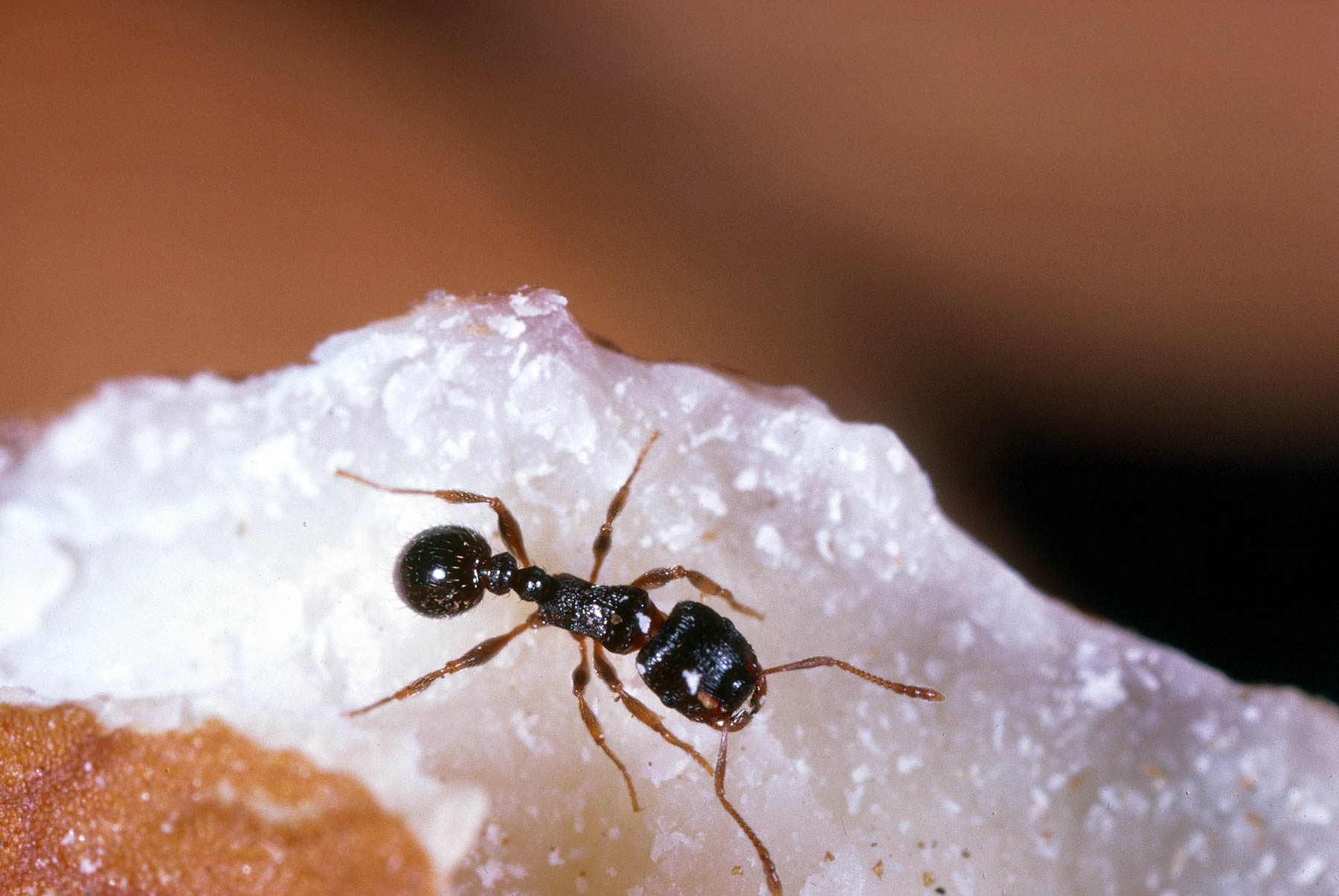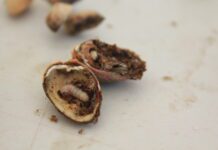
Protein feeding ants can accomplish a task few other insect pests even attempt. Given an opening in an almond shell, they can, in very small bites, eat an entire kernel, leaving an empty peel behind.
Ant feeding, reports Blue Diamond’s Director of Grower Relations Mel Machado, can steal a good portion of an orchard’s crop yield in a short time – before a grower is aware of the problem.
His advice to growers is to “look down.”
“Growers tend to look up, at the trees, but they need to look at the orchard floors and see if they have an ant infestation.”
Know Your Ants
Machado cited a well-known tactic to determine if the ants present in an orchard are protein feeders- the species that feed on almonds as they lay on the ground after shaking, waiting for the pickup machines.
“Secure a snack size chip bag or a hot dog in a zip lock bag to the floor of the orchard where ants are spotted. If you come back and find they have devoured the chips or hot dog, these are the ants that feed on almonds,” Machado said.
Once that determination is made, growers can apply ant bait to knock down ant populations. The catch, Machado said, is that depending on the bait used, control can take 8-9 weeks. Determining the extent of the ant infestation and implementing appropriate control has to start well before harvest.
The University of California Statewide Integrated Pest Management (IPM) Program explains that the two ant species that can pose the most threat to a harvested almond crop on the ground are the pavement and southern fire ant. The pavement ant is more common in the northern San Joaquin and Sacramento valleys. It prefers to nest in sandy or loam soils. This ant is dark brown in color, has a single node, and has coarse hairs on its body.

The southern fire ant tends to be found more in the San Joaquin Valley. It has an amber colored head and thorax with a black abdomen. This ant species swarms out of the nest when disturbed and can deliver a painful sting. Where drip or micro sprinklers are used, the southern fire ant will nest on the edges of the wetted area. Nests are made on berms in flood irrigated orchards with heavy soils. In lighter soils, nests can be both on berms and middles. This ant species prefers to nest in weedy areas. The UC IPM Program notes that damage potential appears to be less in orchards with clean floors. Minimizing weed seeds also eliminates a food source for ants.
Both ant species have peak activity during the morning hours and just prior to sunset.
The southern fire ant can cause more crop damage than the pavement ant. The amount of damage increases the longer the nuts are on the ground. Almond varieties with a tight shell seal or with shell splits less than 0.03-inch-wide typically will have less ant damage. A lighter crop with larger size nuts increases the potential for ant damage.
Depending on anticipated harvest timing, April and May are the recommended times for surveying orchards for ant infestations.
Orchard floors should be surveyed 2-3 days after an irrigation to determine the level of ant activity. The IPM program recommends choosing five survey areas per block, each about 1000 square feet, including soil areas from mid-alley to mid-alley beneath trees. Total colony entrances in all five survey areas. Fifteen or fewer colonies total, and nuts on the ground for four days will result in 0.9 percent damage. The figure increases to 4.9 percent by 21 days. At 45 total colonies the damage increases from 1.4 percent at four days to 7 percent at 21 days.
Choosing Your Bait
Baits are advised to manage potentially damaging ant populations, but they need time to work. To maintain bait quality in the orchard and maximize bait ingestion by ants, the soil surface should be dry when bait is applied. How bait is stored prior to use is also important as the soybean oil that is used as an attractant can become rancid over time. Bags stored for more than a few weeks should be turned over to disperse the soybean oil throughout the cornmeal carrier.
Some of the most common baits are pyriproxyfen (Esteem), and methoprene (Extinguish). These are insect growth regulators. They do not immediately kill foraging worker ants as do abamectin (Clinch) and metaflumizone (Altrevin). Existing foraging worker ants must die off naturally before there is a noticeable decrease in ant numbers. Weed seeds, particularly spurge may attract ants away from baits if their active ingredient degrades rapidly after application.
Kris Tollerup, UCCE Integrated pest management advisor said there is a bait product that provides a faster knockdown of ant infestation for growers who are bumping up to harvest. Metaflumizone (Altrevin) can downsize ant populations in almond orchards in less than a week, Tollerup said. The UC IPM web site has guidelines on use of this product. The pre-harvest interval is three days. A permit from the county agricultural commissioner is required for purchase or use of the product.
Metaflumizone is a corncob grit and soy oil bait. It is only effective against fire ants because they are attracted to the soy oil. This bait should be applied when ants are most active and when soil temperature is above 60 degrees F. The UC IPM guidelines report that treatments are most effective if applied 2 days after irrigation, when ant activity is at a maximum. Irrigation should not resume until at least 24 hours after application. Do not apply if rainfall is anticipated within 4 to 6 hours after application. This bait can be broadcast using properly calibrated ground equipment, but spot applications at the location of the ant colonies are advised. Re-treatment should be considered after three to four months.
Dry weather and warmer temperatures going into March are likely the causes of southern fire ant early season activity. Tollerup said that as temperatures warm this spring, southern fire ant colony numbers will begin to build. That does not necessarily mean the total number of colonies will increase.
Tollerup said mating flights occur in May, July, and late Sept in many ant species. It takes about four to six weeks before the nascent colonies become noticeably active.
Knowing your ant species, how they behave and matching them to the right bait can help bring season long control.










